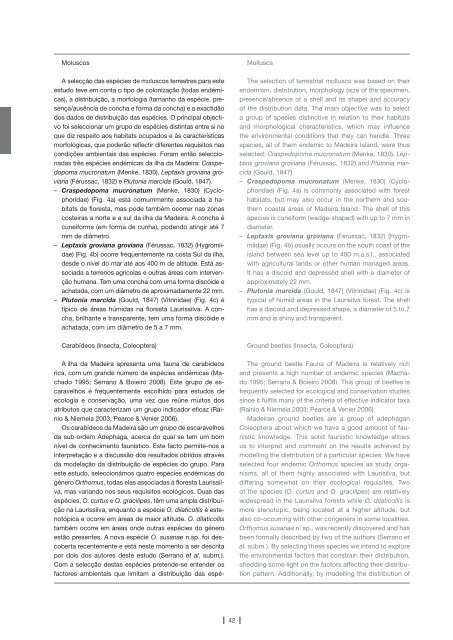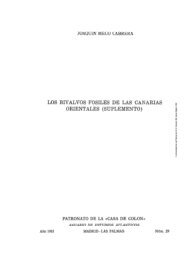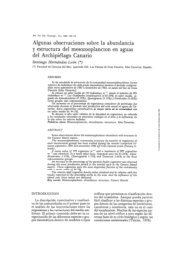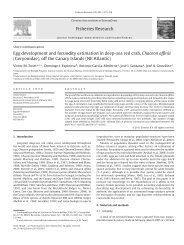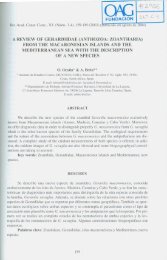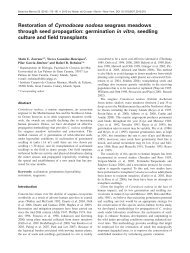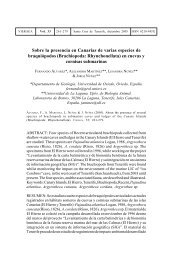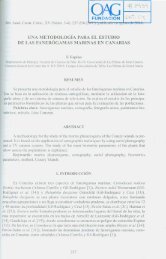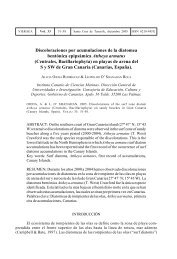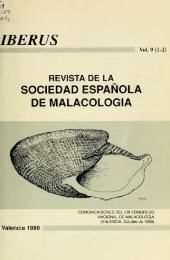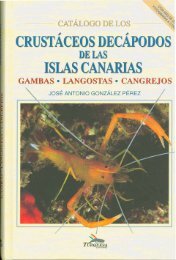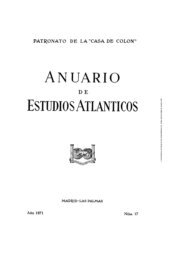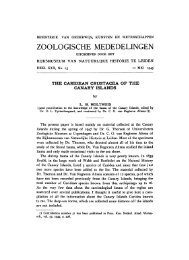of the madeira and selvagens archipelagos - redmic
of the madeira and selvagens archipelagos - redmic
of the madeira and selvagens archipelagos - redmic
Create successful ePaper yourself
Turn your PDF publications into a flip-book with our unique Google optimized e-Paper software.
Moluscos<br />
A selecção das espécies de moluscos terrestres para este<br />
estudo teve em conta o tipo de colonização (todas endémicas),<br />
a distribuição, a morfologia (tamanho da espécie, presença/ausência<br />
de concha e forma da concha) e a exactidão<br />
dos dados de distribuição das espécies. O principal objectivo<br />
foi seleccionar um grupo de espécies distintas entre si no<br />
que diz respeito aos habitats ocupados e às características<br />
morfológicas, que poderão reflectir diferentes requisitos nas<br />
condições ambientais das espécies. Foram então seleccionadas<br />
três espécies endémicas da ilha da Madeira: Craspedopoma<br />
mucronatum (Menke, 1830), Leptaxis groviana groviana<br />
(Férussac, 1832) e Plutonia marcida (Gould, 1847).<br />
– Craspedopoma mucronatum (Menke, 1830) (Cyclophoridae)<br />
(Fig. 4a) está comummente associada a habitats<br />
de floresta, mas pode também ocorrer nas zonas<br />
costeiras a norte e a sul da ilha da Madeira. A concha é<br />
cuneiforme (em forma de cunha), podendo atingir até 7<br />
mm de diâmetro.<br />
– Leptaxis groviana groviana (Férussac, 1832) (Hygromiidae)<br />
(Fig. 4b) ocorre frequentemente na costa Sul da ilha,<br />
desde o nível do mar até aos 400 m de altitude. Está associada<br />
a terrenos agrícolas e outras áreas com intervenção<br />
humana. Tem uma concha com uma forma discóide e<br />
achatada, com um diâmetro de aproximadamente 22 mm.<br />
– Plutonia marcida (Gould, 1847) (Vitrinidae) (Fig. 4c) é<br />
típico de áreas húmidas na floresta Laurissilva. A concha,<br />
brilhante e transparente, tem uma forma discóide e<br />
achatada, com um diâmetro de 5 a 7 mm.<br />
Carabídeos (Insecta, Coleoptera)<br />
A ilha da Madeira apresenta uma fauna de carabídeos<br />
rica, com um gr<strong>and</strong>e número de espécies endémicas (Machado<br />
1995; Serrano & Boieiro 2008). Este grupo de escaravelhos<br />
é frequentemente escolhido para estudos de<br />
ecologia e conservação, uma vez que reúne muitos dos<br />
atributos que caracterizam um grupo indicador eficaz (Rainio<br />
& Niemela 2003; Pearce & Venier 2006).<br />
Os carabídeos da Madeira são um grupo de escaravelhos<br />
da sub -ordem Adephaga, acerca do qual se tem um bom<br />
nível de conhecimento faunístico. Este facto permite -nos a<br />
interpretação e a discussão dos resultados obtidos através<br />
da modelação da distribuição de espécies do grupo. Para<br />
este estudo, seleccionámos quatro espécies endémicas do<br />
género Orthomus, todas elas associadas à floresta Laurissilva,<br />
mas vari<strong>and</strong>o nos seus requisitos ecológicos. Duas das<br />
espécies, O. curtus e O. gracilipes, têm uma ampla distribuição<br />
na Laurissilva, enquanto a espécie O. dilaticollis é estenotópica<br />
e ocorre em áreas de maior altitude. O. dilaticollis<br />
também ocorre em áreas onde outras espécies do género<br />
estão presentes. A nova espécie O. susanae n.sp. foi descoberta<br />
recentemente e está neste momento a ser descrita<br />
por dois dos autores deste estudo (Serrano et al. subm.).<br />
Com a selecção destas espécies pretende -se entender os<br />
factores ambientais que limitam a distribuição das espé-<br />
42<br />
Molluscs<br />
The selection <strong>of</strong> terrestrial molluscs was based on <strong>the</strong>ir<br />
endemism, distribution, morphology (size <strong>of</strong> <strong>the</strong> specimen,<br />
presence/absence <strong>of</strong> a shell <strong>and</strong> its shape) <strong>and</strong> accuracy<br />
<strong>of</strong> <strong>the</strong> distribution data. The main objective was to select<br />
a group <strong>of</strong> species distinctive in relation to <strong>the</strong>ir habitats<br />
<strong>and</strong> morphological characteristics, which may influence<br />
<strong>the</strong> environmental conditions that <strong>the</strong>y can h<strong>and</strong>le. Three<br />
species, all <strong>of</strong> <strong>the</strong>m endemic to Madeira Isl<strong>and</strong>, were thus<br />
selected: Craspedopoma mucronatum (Menke, 1830), Leptaxis<br />
groviana groviana (Férussac, 1832) <strong>and</strong> Plutonia marcida<br />
(Gould, 1847).<br />
– Craspedopoma mucronatum (Menke, 1830) (Cyclophoridae)<br />
(Fig. 4a) is commonly associated with forest<br />
habitats, but may also occur in <strong>the</strong> nor<strong>the</strong>rn <strong>and</strong> sou<strong>the</strong>rn<br />
coastal areas <strong>of</strong> Madeira Isl<strong>and</strong>. The shell <strong>of</strong> this<br />
species is cuneiform (wedge -shaped) with up to 7 mm in<br />
diameter.<br />
– Leptaxis groviana groviana (Férussac, 1832) (Hygromiidae)<br />
(Fig. 4b) usually occurs on <strong>the</strong> south coast <strong>of</strong> <strong>the</strong><br />
isl<strong>and</strong> between sea level up to 400 m.a.s.l., associated<br />
with agricultural l<strong>and</strong>s or o<strong>the</strong>r human managed areas.<br />
It has a discoid <strong>and</strong> depressed shell with a diameter <strong>of</strong><br />
approximately 22 mm.<br />
– Plutonia marcida (Gould, 1847) (Vitrinidae) (Fig. 4c) is<br />
typical <strong>of</strong> humid areas in <strong>the</strong> Laurisilva forest. The shell<br />
has a discoid <strong>and</strong> depressed shape, a diameter <strong>of</strong> 5 to 7<br />
mm <strong>and</strong> is shiny <strong>and</strong> transparent.<br />
Ground beetles (Insecta, Coleoptera)<br />
The ground beetle Fauna <strong>of</strong> Madeira is relatively rich<br />
<strong>and</strong> presents a high number <strong>of</strong> endemic species (Machado<br />
1995; Serrano & Boieiro 2008). This group <strong>of</strong> beetles is<br />
frequently selected for ecological <strong>and</strong> conservation studies<br />
since it fulfils many <strong>of</strong> <strong>the</strong> criteria <strong>of</strong> effective indicator taxa<br />
(Rainio & Niemela 2003; Pearce & Venier 2006).<br />
Madeiran ground beetles are a group <strong>of</strong> adephagan<br />
Coleoptera about which we have a good amount <strong>of</strong> faunistic<br />
knowledge. This solid faunistic knowledge allows<br />
us to interpret <strong>and</strong> comment on <strong>the</strong> results achieved by<br />
modelling <strong>the</strong> distribution <strong>of</strong> a particular species. We have<br />
selected four endemic Orthomus species as study organisms,<br />
all <strong>of</strong> <strong>the</strong>m highly associated with Laurisilva, but<br />
differing somewhat on <strong>the</strong>ir ecological requisites. Two<br />
<strong>of</strong> <strong>the</strong> species (O. curtus <strong>and</strong> O. gracilipes) are relatively<br />
widespread in <strong>the</strong> Laurisilva forests while O. dilaticollis is<br />
more stenotopic, being located at a higher altitude, but<br />
also co -occurring with o<strong>the</strong>r congeners in some localities.<br />
Orthomus susanae n. sp., was recently discovered <strong>and</strong> has<br />
been formally described by two <strong>of</strong> <strong>the</strong> authors (Serrano et<br />
al. subm.). By selecting <strong>the</strong>se species we intend to explore<br />
<strong>the</strong> environmental factors that constrain <strong>the</strong>ir distribution,<br />
shedding some light on <strong>the</strong> factors affecting <strong>the</strong>ir distribution<br />
pattern. Additionally, by modelling <strong>the</strong> distribution <strong>of</strong>


